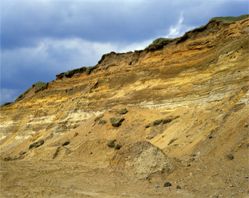
IMPLICATIONS
Image: Glacial sands and gravels within Frettingham Lime Co. Pits. Norfolk. P210935 BGS© NERC
Mapping the 3D form of buried valleys is not just of benefit to Quaternary geology - there is value for engineers and the water and aggregate industries. Our interest is the interaction of buried valleys with hydrological systems. Knowing the spatial distribution and form of buried valleys allows us to develop an idea of how these pre-glacial and subglacial channel systems have shaped modern river networks and aquifer characteristics.
For example, we observe that modern day rivers often follow the same course as the buried channels. Buried-valley infills may themselves form viable aquifer units. Though spatially restricted, their depth makes them an inviting prospect for groundwater resources, and countries such as Denmark and USA are already exploiting them.
Permeability of East Anglian buried valley infill deposits was calculated using grain-size distribution. Although there is incomplete coverage across the network, there are higher permeability deposits, associated with a basal sand and gravel unit within the Bytham River and River Stour valley deposits, occurring below a shallower, less permeable fill. The distribution of valley infill deposits is not unexpected for a valley of polyphase origin, with successive phases of pre-glacial, glacial and post-glacial erosion and deposition having given rise to a complex sequence of both layered and unsorted deposits of varying permeability.
In East Anglia, the superficial deposits in the north and west of the region are largely underlain by the Chalk Group - a principal aquifer supporting over 40% of public water supply locally. Consequently there is a drive to understand the hydrological characteristics of the chalk, including its resource potential and its vulnerability to contamination.
In mapping the buried valleys we see a potential control being exerted by the channels on the underlying chalk. Comparatively high transmissivity values appear to be associated with several buried valleys, the highest of which being coincident with the Bytham River valley and the modern day Black Bourn. With raised transmissivity provided initially by bedrock structure, chalk permeability is likely to have been enhanced by subglacial hydrostatic pressure and dissolution beneath the ancient river deposits. A zone of high transmissivity is also observed along the River Stour buried valley, which is also thought to be part of the pre-glacial Bytham drainage network.
Where hydrostatic pressures were sufficient, subglacial meltwater could have eroded significant sections of the pre-glacially weathered chalk, before the tunnel valleys were formed. The engineering properties of chalk beneath buried valleys tends to support this idea – soft, more weathered chalk occurring under the pre-glacial Bytham River, River Stour and the pre-diversionary Thames; harder chalk occurring under the tunnel valleys of sub-glacial origin.
In line with this argument we see the harder chalk hosting the more deeply eroded sections of the buried valleys where thicker buried valley deposits are recorded. The relationship between the buried valley and the underlying chalk and its influence on aquifer characteristics is not simple and would appear to depend not only on the chalk unit within which valley is eroded but also on the origin of the valley. Coupled with this, the buried valleys are highly heterogeneous both in form and nature of infill. It is the juxtaposition of higher permeability fill within buried valleys (particularly those of the Stour and ancient Bytham river) with zones of high transmissivity in the underlying chalk that arouses interest. While these zones provide a hotspot for preferential groundwater recharge and aquifer productivity, they also provide potentially rapid pathways for contaminants, leaving the chalk aquifer extremely vulnerable to polluting activities.
Delineating buried valleys in 3D does not by itself answer all questions with respect to the management of groundwater systems. It does however provide a focus for future research and is of benefit to other disciplines. Whether the interest is engineering, aggregates or offshore exploration, there is much to be gained from the 3D delineation of these buried valley features.